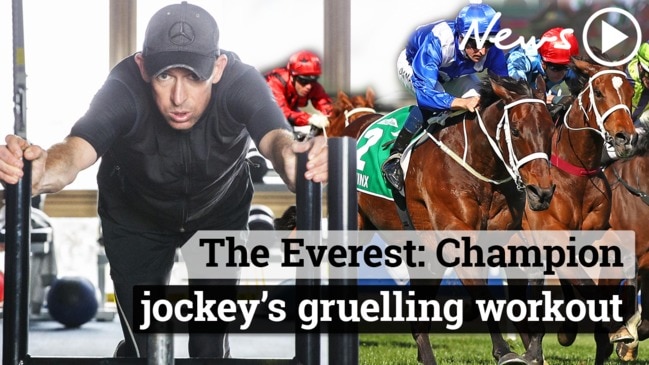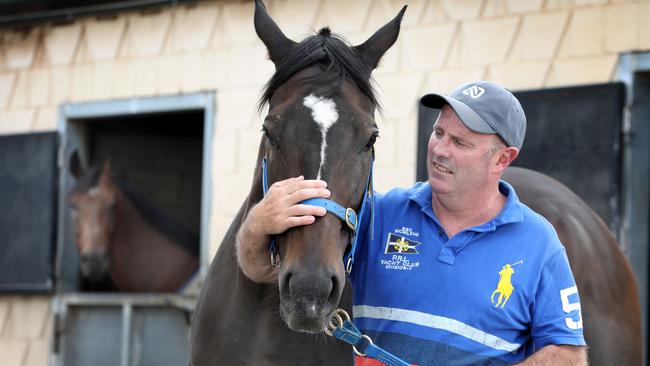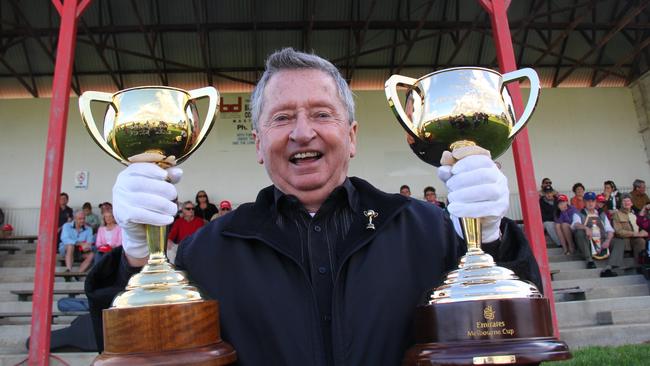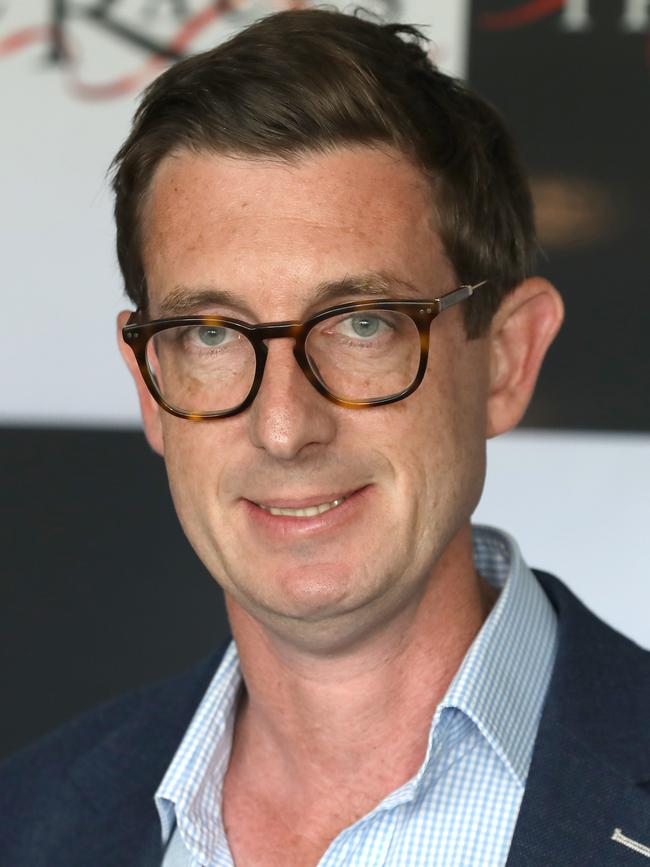Funding cuts could cost SA racing its significance on the Australian racing calendar
South Australian horse racing will become irrelevant on the national stage and jobs will be forced interstate, industry heavyweights say, after the State Government pulled vital funding.

SA News
Don't miss out on the headlines from SA News. Followed categories will be added to My News.
Read below:
John Letts: “It’s a disgrace”
Interstate beckons for last of Hayes dynasty
South Australian horse racing will become irrelevant on the national stage and jobs will be forced interstate, industry heavyweights say, after the State Government pulled vital funding.
Adelaide’s hallmark Group 1 events – the Goodwood and Sangster Stakes – will lose their $1 million prizemoney status next year after the Government announced it would no longer provide its $3 million sponsorship of the Adelaide Festival of Racing.
The move will also force industry body Thoroughbred Racing SA to find a further $2.25 million in savings by cutting infrastructure funding for its 25 member clubs across the state. The industry also failed to gain much-needed Government support regarding the reinvestment of the con-sumption gambling tax, which nets $16 million in revenue annually, back into the horse racing. Famed South Australian jockey and media identity John Letts said the scenario was a “disgrace”.
“We’re a small state with a small population and I don’t for a moment suggest we can put on a ($13 million) Everest (feature race in NSW) or compete with the Melbourne Spring Carnival,’’ TRSA chairwoman Frances Nelson said.
“But the way things are with the lack of recognition by Government of our importance, we can’t maintain our place nationally. The danger for us if we can’t maintain prizemoney, we may not maintain our rating which will significantly affect us long term.’’

South Australia was the first state to introduce the POC tax on all bets made by SA racing and sports punters at 15 per cent, significantly higher than both Victoria (eight per cent) and New South Wales (10 per cent).
Queensland racing recently took strike action in October, which resulted in a $26 million prizemoney injection, while Racing Victoria announced last week a $40 million prizemoney boost, $33 million coming from its State Government.
Thoroughbred racing employs more than 3600 people across South Australia and generates $400 million annually in economic benefits. Ms Nelson said the solution was simple.
“If the Government were to divert to us, which as they should, the net tax which they collect on racing that would be $13m a year and then we could undertake the projects we’ve already put in our strategic plan to grow jobs and grow the industry,’’ she said.
“I think the Treasurer wants to introduce a surplus Budget in June and he has said he doesn’t believe in ad hoc grants in between Budgets, that everything must go through a Budget process, so we have six months to convince we need to be a part of that process.’’
Ms Nelson said they would now need to find $2.25 million in savings, likely in the form of cuts to infrastructure spending at 25 clubs across SA.
There was a one-off $4.85 million payment to the SA industry in June, but repeated lobbying to Treasurer Rob Lucas and Racing Minister Corey Wingard has failed.
“Our immediate priority is to repair the Budget,’’ a state government spokeswoman said. “Any calls for significant taxpayer-funded expenditure on the industry will be considered with all other funding submissions in the lead-up to next year’s Budget.”
South Australian Trainers’ Association president Richard Jolly said it was a dangerous time for SA racing.
“A lot of trainers have big investments, properties, stock and people, we’re finding it very hard to sustain our business and with no support from the Government it is shattering for all trainers,” he said.
“There are trainers leaving the state; I’ve got family coming through this industry and I have to seriously look to where our future is.”
The cost of a dwindling South Australian Racing industry
PRIZEMONEY CHANGES 2017 to 2018
GROUP 1 GOODWOOD:
$1m to $750,000
GROUP 1 SANGSTER:
$1m to $600,000
GROUP 1 SA DERBY: $600,000 to $500,000
GROUP 1 AUSTRALASIAN OAKS: Stays at $500,000
GROUP 2 EUCLASE STAKES: $500,000 to $250,000
GROUP 2 QUEEN OF THE SOUTH: $300,000 to $200,000
SA DEPARTURES
- TRAINERS
Bart Cummings
David Hayes
John Hawkes
Mark Kavanagh
Lloyd Kennewell
Nick Smart
Phillip Stokes
JOCKEYS
Dwayne Dunn
Kerrin McEvoy
SA horse racing needs State Government help

It’s just not right, in fact it’s a disgrace.
The South Australian racing industry needs the support of the State Government more now than ever. It’s a crucial time for racing in Australia.
We have racing’s two power states in Victoria and New South Wales going blow for blow, announcing million-dollar feature races, and we’ve now lost our two $1 million races – the Goodwood and Sangster Stakes – during Adelaide’s Festival of Racing.
All other states are going ahead in leaps and bounds and getting the Government support they need. It took strike action for Queensland to get their Government’s attention and ultimately they got the right result.
Seeing South Australian racing forced to reduce its key feature race in 2019 is a sad situation and something that needs to be addressed. Sure, the current Government isn’t entirely to blame for the economic situation but they seriously need to rethink the strategy and look long-term, not be thinking short-term.
They are going to force more than 3500 people out of work by neglecting one of SA’s most important industries. The Government is there to create jobs and not lose them – we can’t afford them to be making decisions likes this.
We’ve already lost some of the biggest names in the sport like Hayes, McEvoy, Dunn, Stokes, Kavanagh and Kennewell interstate and we certainly aren’t in a position to be driving more key participants away from SA.
John Letts is a two-time Melbourne Cup winning jockey
Interstate beckons for last of a dynasty

The Hayes family is synonymous with horse racing in South Australia.
But a decision to withdraw State Government support of the industry threatens to send a remaining link of the family dynasty interstate.
Cornerstone Stud owner and passionate South Australian Sam Hayes, the nephew of SA racing icon Colin Hayes and cousin of Hall of Fame trainer David Hayes, said Friday marked “a sad day for South Australian racing”.
He believes the solution to keeping SA relevant in the national horse racing market is simple: reinvest the point of consumption gambling tax from racing back into the industry.
“Every other state in Australia is reinvesting in their industry; I can’t help but feel incredibly despondent,’’ Hayes said. “Prizemoney cuts, a lack of commitment from our Government to invest money from the tax back into the industry that is funding the tax. It’s easily addressed; it’s an easy fix.
“All you have to do is invest the POC (tax) back into our industry and we can go forward again. We’re going backwards when everywhere else is going forward, it’s incredibly demoralising.”
Colin Hayes set up one of the world’s most successful breeding and training facilities at Lindsay Park in the Barossa Valley, which was then taken on by David before he consolidated his based at Euroa in country Victoria almost 10 years ago.
Sam Hayes, above, said the lure of moving interstate was becoming harder to ignore.
“I love living in South Australia, I love the Barossa Valley, I love where I live but income for my competitors is growing, and mine is decreasing,’’ he said. “While I love the Barossa Valley, the Yarra Valley is looking pretty good at the moment.
“I can probably earn double the money interstate than I can here.’’
Hayes said while it was clear the Government was trying to balance the books ahead of next year’s Budget, it was missing the mark by ignoring the racing industry, which employs 3600 South Australians.
“I implore the Government to think twice about this,” he said. “I understand about the benefit of a surplus in the economy but we’re talking about a small amount of money that has a very big impact on jobs, employment and infrastructure for a small investment.
“There comes a point where you can’t afford to lose any more. While other racing industries are growing, we’re doing the opposite.’’


